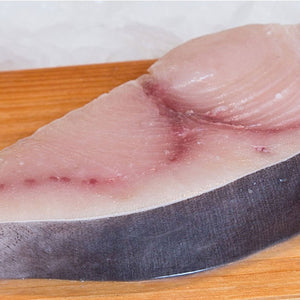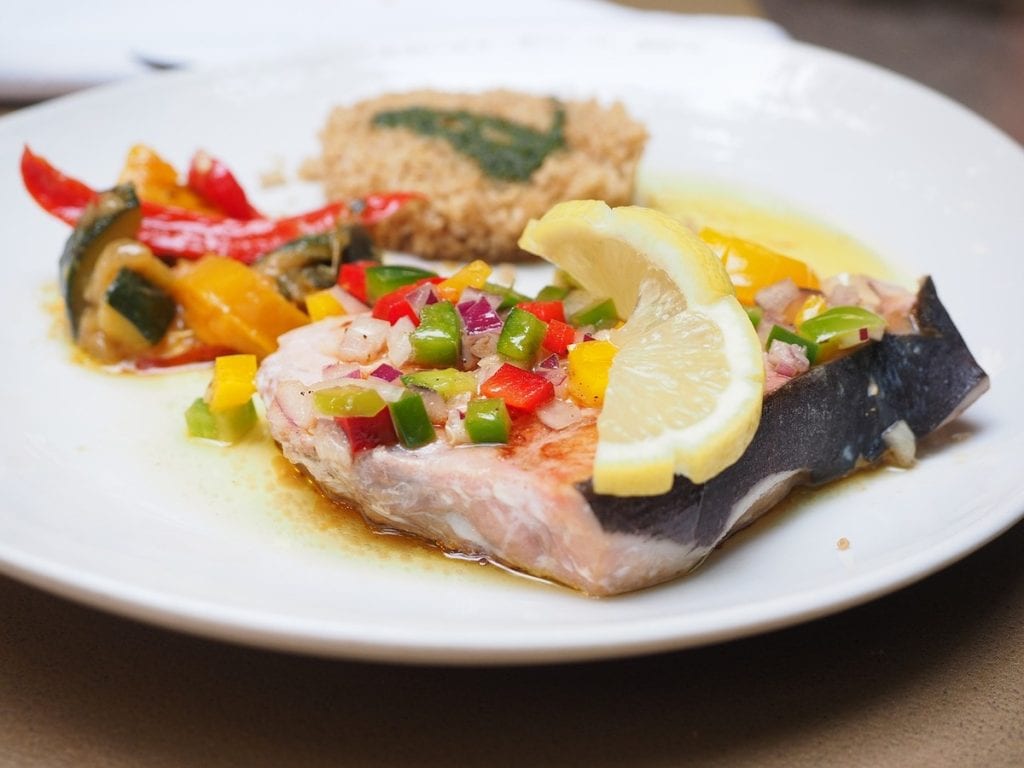Introduction To Swordfish Taste

Swordfish, a popular seafood choice, offers a unique and delightful flavor. With its mild meaty taste, reminiscent of tuna, swordfish is a versatile ingredient that can be enjoyed in various dishes. The flavor profile is characterized by a hint of sweetness and a subtle briny essence, making it a favorite among seafood enthusiasts. The taste can vary depending on factors such as the cut of the fish, its freshness, and the cooking method. Whether grilled, broiled, or pan-seared, swordfish brings a rich and fulfilling flavor experience to the table.
Swordfish Characteristics And Culinary Uses
Swordfish is a highly versatile seafood that is appreciated for its unique characteristics and culinary uses. Known for its firm and meaty texture, swordfish is often compared to tuna in terms of flavor. Its mild taste makes it a popular choice for grilling, broiling, and pan-searing, allowing it to be enjoyed in a variety of dishes. The high moisture content and rich, fatty flavor of swordfish make it an excellent option for those who prefer a more hearty and fulfilling seafood experience. It is often served as steaks and can be paired with a wide range of seasonings and accompaniments to enhance its flavor.
Popular Methods Of Cooking Swordfish
Popular methods of cooking swordfish include grilling, broiling, baking, and pan-searing. Grilling is a popular method that imparts a smoky flavor and creates a delicious caramelized crust on the outside while keeping the interior moist. Broiling is another option that allows for quick cooking and can result in a slightly charred and crispy exterior. Baking swordfish in the oven is a great choice for those who prefer a more tender and juicy texture. Lastly, pan-searing swordfish in a hot skillet with oil or butter can create a flavorful crust while preserving the natural moisture of the fish. These cooking methods highlight the meaty texture and delicate flavor of swordfish.
Flavor Profile Of Swordfish

Swordfish has a unique flavor profile that sets it apart from other seafood options. Its meaty texture is complemented by a mild, almost sweet taste. This flavor is enhanced by a subtle briny essence that adds depth to the overall taste. The flavor can vary depending on factors such as the freshness of the cut and the method of preparation. Whether grilled, baked, or pan-seared, swordfish remains deliciously flavorful, making it a versatile choice for various culinary applications. Its distinctive taste makes it a popular seafood sensation among those who appreciate its sweet and mildly briny flavor.
Sweet And Mild Flavors Of Swordfish
Swordfish is renowned for its sweet and mild flavors that appeal to a wide range of palates. The meaty texture of swordfish is complemented by its subtly sweet taste, making it a delight to savor. This mild flavor is enhanced by a hint of brininess, adding a unique depth to the overall taste experience. Whether grilled, baked, or pan-seared, swordfish retains its deliciously flavorful profile. Its distinct sweetness sets it apart from other seafood options, making swordfish a sought-after choice for those who appreciate a subtly sweet and mildly briny flavor.
Textural Aspects Of Swordfish Meat
Swordfish meat is known for its firm and meaty texture, similar to that of steak. Unlike flaky fish, swordfish retains its structure even after cooking, making it ideal for grilling, baking, or pan-searing. The dense and sturdy texture of swordfish allows it to hold up well to various cooking methods without falling apart. When cooked properly, swordfish maintains its juiciness and tenderness, creating a satisfying bite. Its robust texture adds a satisfying element to the overall dining experience, further enhancing its appeal.
Factors Influencing Swordfish Taste

The taste of swordfish can be influenced by various factors. One important factor is the diet and habitat of the swordfish. Swordfish feed on a variety of prey, including squid, small fish, and crustaceans, which can contribute to their flavor. The water temperature and salinity of their habitat also play a role in the taste of the fish. Additionally, the way the swordfish is prepared and seasoned can impact its flavor. Proper cooking techniques and the use of complementary spices and marinades can enhance the natural taste of the swordfish.
Diet And Habitat Of Swordfish
Swordfish are predatory fish that have a diverse diet and inhabit both cold and warm waters. They primarily feed on squid, small fish, and crustaceans, which contribute to their unique flavor profile. Their diet of oily and fatty prey gives their meat a rich and luscious taste. Swordfish can be found in various oceanic regions, including the Atlantic, Pacific, and Indian Oceans. They prefer temperate to tropical waters and can tolerate a wide range of salinity levels. These factors, along with the temperature and nutrient content of their habitat, influence the taste and quality of the swordfish meat.
Preparation And Seasoning Techniques
When it comes to preparing and seasoning swordfish, there are a few techniques that can elevate its flavor. Before cooking, it’s important to properly clean and trim the swordfish, removing any skin or bones. This will ensure a smooth and enjoyable dining experience. When it comes to seasoning, simplicity is key. Good quality sea salt and freshly ground black pepper can enhance the natural flavors of the fish. Additionally, adding a squeeze of lemon juice or a drizzle of olive oil can provide a refreshing citrusy touch.
Comparing Swordfish Taste To Other Seafoods

When it comes to comparing swordfish taste to other seafood options, there are a few notable differences. While swordfish has a slightly sweet and mild flavor, salmon offers a stronger, richer taste. Tuna, on the other hand, has a meatier and more robust flavor profile. Mackerel, known for its distinctively fishy taste, is quite different from swordfish. Each seafood variety has its own unique taste that can be enjoyed in various dishes and preparations. It ultimately comes down to personal preference when choosing between the different flavors of these seafood options.
Contrasting Swordfish Taste With Salmon, Tuna, And Mackerel
When comparing the taste of swordfish to other popular seafood options, there are noticeable differences. While swordfish has a slightly sweet and mild flavor, salmon offers a stronger, richer taste. Tuna, on the other hand, has a meatier and more robust flavor profile. Mackerel, known for its distinctively fishy taste, is quite different from swordfish. Each seafood variety has its own unique taste, allowing for a range of flavor experiences. Ultimately, personal preference plays a significant role in choosing between the different flavors of these seafood options.
Sensory Experience Of Consuming Swordfish
Consuming swordfish is a sensory delight that engages multiple senses. As you take your first bite, you will experience the firm and meaty texture of the swordfish, which adds a satisfying chewiness to the overall experience. The flavors unfold in your mouth, revealing a delicate balance of sweetness and brininess, complemented by the mild and slightly savory undertones. The buttery tenderness of the swordfish provides a luxurious mouthfeel, making every bite a truly indulgent sensation. Whether grilled, baked, or seared, the sensory experience of consuming swordfish is sure to leave a lasting impression.
Cooking Tips And Recipes For Swordfish

When it comes to cooking swordfish, there are a few tips and recipes that can enhance the flavor and texture of this delectable seafood. Here are some suggestions:
- Grilling: Marinate the swordfish with a mixture of olive oil, lemon juice, garlic, and herbs for about 30 minutes before grilling. Cook the steaks for about 4-6 minutes per side over medium-high heat until they are opaque and easily flake with a fork.
- Baking: Place the seasoned swordfish steaks in a baking dish and drizzle with olive oil. Bake at 400°F (200°C) for about 12-15 minutes until the fish is cooked through and flakes easily.
- Searing: Heat a skillet over high heat and coat with oil. Season the swordfish with salt and pepper and sear for 2-3 minutes per side until browned. Finish cooking in a preheated oven at 400°F (200°C) for another 5-7 minutes.
- Lemon Butter Sauce: Melt butter in a saucepan and add minced garlic, lemon juice, and chopped parsley. Drizzle the sauce over grilled or baked swordfish for added flavor.
- Mediterranean Style: Create a Mediterranean-inspired dish by topping grilled swordfish with a mixture of diced tomatoes, olives, capers, red onion, and fresh herbs like basil and parsley.
Remember to season the swordfish with salt and pepper before cooking, and always cook it to an internal temperature of 145°F (63°C) for optimal safety. Enjoy the delightful taste of swordfish with these cooking tips and recipes.
This section adapted from
Grilling, Baking, And Searing Swordfish
Grilling, baking, and searing are popular cooking methods for swordfish that enhance its natural flavors. When grilling swordfish, marinate the steaks in a mixture of olive oil, lemon juice, garlic, and herbs before cooking. Grill the steaks for about 4-6 minutes per side over medium-high heat until they are opaque and flaky. For baking, place seasoned swordfish steaks in a baking dish and drizzle with olive oil. Bake at 400°F for about 12-15 minutes until the fish is cooked through. To sear swordfish, heat a skillet over high heat, coat with oil, and brown the steaks for 2-3 minutes per side before finishing in the oven at 400°F for another 5-7 minutes. These cooking methods bring out the delicious flavors and provide a variety of textures to enjoy.
This section adapted from
Recommended Seasonings And Accompaniments
Swordfish pairs well with a variety of seasonings and accompaniments that enhance its mild flavor. Common seasonings include lemon, garlic, butter, herbs like rosemary and thyme, and a sprinkle of salt and pepper. For a bolder flavor, you can use marinades or sauces with ingredients such as soy sauce, ginger, and chili flakes. Grilled vegetables, such as asparagus or zucchini, make for delicious side dishes that complement the taste of swordfish. Additionally, serving the fish with a light salad, couscous, or rice pilaf adds a nice contrast in textures.
Conclusion

In conclusion, swordfish offers a unique flavor profile that combines sweetness with a subtle briny taste. Its meat is dense and hearty, making it a popular choice for grilling, baking, and searing. Swordfish pairs well with various seasonings and accompaniments, such as lemon, garlic, and grilled vegetables. When compared to other seafood options like salmon, tuna, and mackerel, swordfish stands out with its distinct flavor and texture. However, it’s important to consider the sustainability of swordfish consumption and its potential impact on marine ecosystems. Overall, swordfish provides a delicious and versatile seafood option for those seeking a flavorful and satisfying meal.
Nutritional Benefits Of Swordfish
Swordfish not only offers a delightful taste but also provides several nutritional benefits. It is a rich source of protein, which is essential for muscle growth and repair. Additionally, swordfish is packed with omega-3 fatty acids, which support heart health and reduce inflammation. It is also a good source of various minerals, including phosphorus and potassium, which are crucial for maintaining strong bones and regulating blood pressure. Moreover, swordfish is low in saturated fat and cholesterol, making it a healthy choice for those watching their lipid intake.
Sustainability Considerations In Consuming Swordfish
Sustainability is an important factor to consider when consuming swordfish. Due to overfishing and inadequately managed fishing practices, swordfish populations have been declining in some regions. To ensure the long-term viability of swordfish, it is essential to choose swordfish products that are sustainably sourced. Look for certifications such as MSC (Marine Stewardship Council) or labels indicating the swordfish was caught using sustainable methods. By making eco-conscious choices, consumers can help protect swordfish populations and support responsible fishing practices for a more sustainable seafood industry.
FAQ About What Does Swordfish Taste Like? Delving Into Seafood Flavor
Q: What does swordfish taste like?
A: Swordfish has a mild, slightly sweet flavor with a meaty texture. It is often compared to lean beef or pork but with a hint of the sea.
Q: How should swordfish be cooked to bring out its best flavor?
A: Swordfish is versatile and can be grilled, baked, broiled, or even pan-seared. However, it is important not to overcook it to keep it moist and flavorful.
Q: Are there any recommended seasonings or marinades for swordfish?
A: Swordfish pairs well with various seasonings like lemon, garlic, herbs such as rosemary or thyme, and spices like paprika or black pepper. Marinating it in a mixture of olive oil, citrus juice, and herbs can enhance its taste.
Q: Is swordfish a fishy-tasting seafood?
A: Swordfish is not as “fishy” as some other seafood varieties. Its flavor is more subtle, making it appealing to those who are not fans of strong fish flavors.
Q: Can swordfish be used in different types of dishes?
A: Yes, swordfish is commonly used in recipes such as kebabs, tacos, pasta dishes, and salads. Its firm texture makes it ideal for grilling and showcasing in various culinary creations.
Q: How should swordfish be stored to maintain its flavor?
A: Swordfish should be stored in the refrigerator at or below 40°F (4°C) and consumed within 1-2 days for optimal freshness and flavor. It is best to wrap it tightly in plastic or foil to prevent odors from other foods affecting it.

Le Petit Cafe is more than just a coffee shop; it’s a cozy haven for coffee enthusiasts and food lovers. We are located at 26499 Jefferson Ave. Suite F, Murrieta, CA, in the heart of California, our café has been serving delightful coffee, delicious pastries, and savory meals since [year of establishment]. Our story begins with a passion for creating a warm, inviting space where friends, families, and colleagues can gather to savor life’s simple pleasures. The aroma of freshly brewed coffee and the sound of frothing milk greet our guests as they enter our welcoming atmosphere.